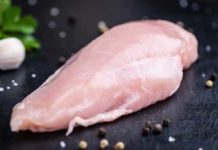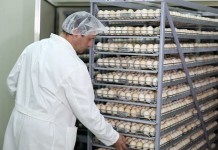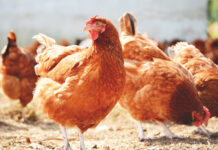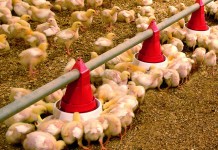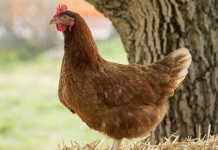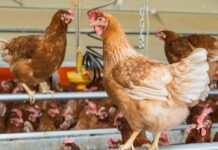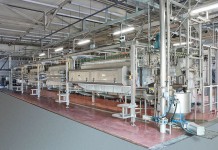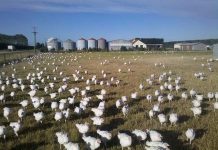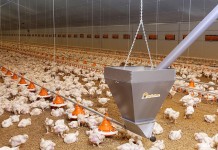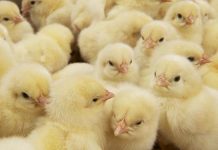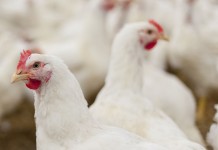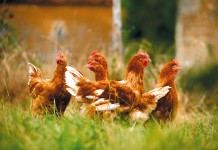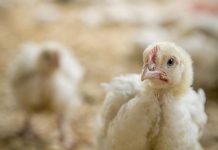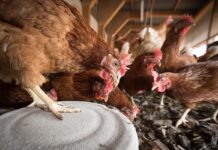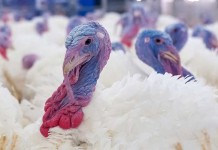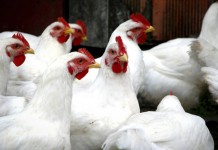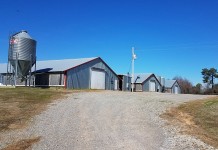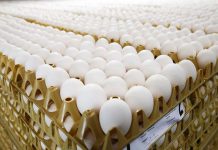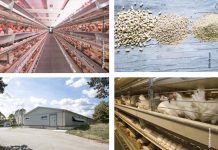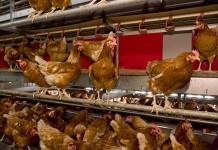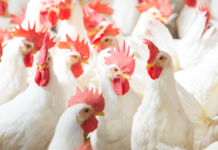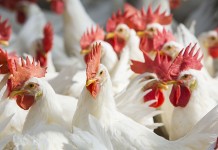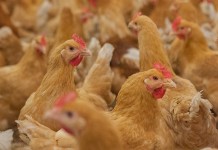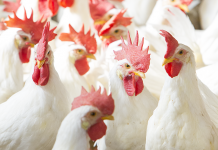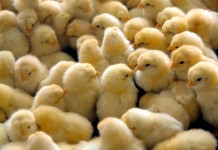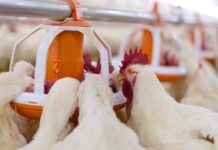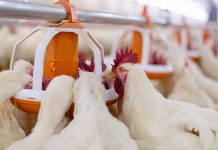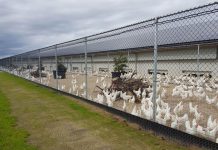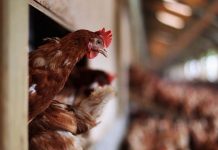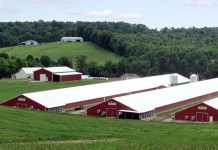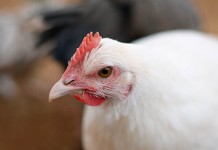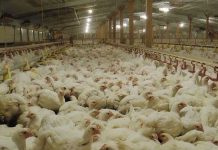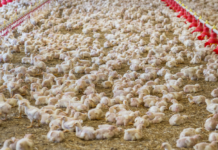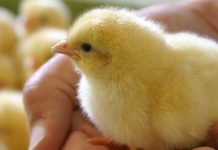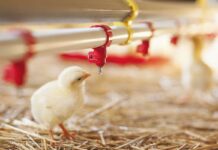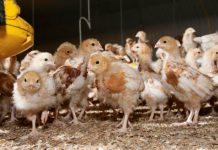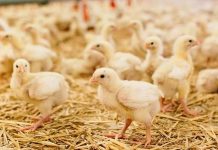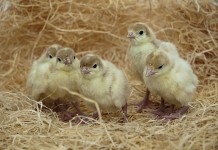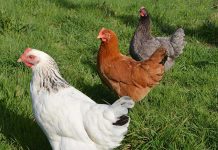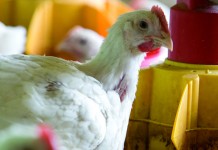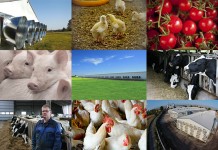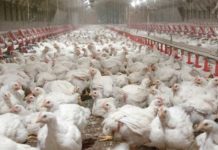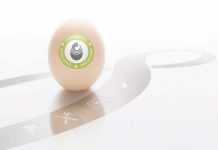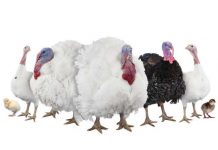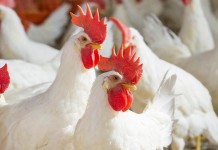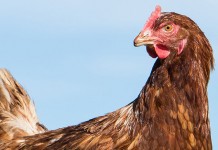New method to detect woody breast fillets
USPOULTRY and the USPOULTRY Foundation announced the completion of a funded research project at Auburn University in Auburn, Alabama, in which researchers found a...
Optimal fat utilisation by Intra Liposol at broilers
It is difficult - especially for young animals - to optimally digest the range of fats and oils in the diet. This leads to...
Limiting embryonic overheating during incubation
Embryonic overheating can represent an issue for incubators. For many things in life, a change in temperature of +0.5°C is hardly noticeable. However, for...
Effect of difference doses of Newcastle disease vaccine immunization on broilers
Influence on growth performance, plasma variables and immune response
As a member of the Paramyxoviridae group, Newcastle disease virus (NDV) is the key causative agent...
How can the poultry industry become carbon neutral?
Following the Paris climate agreement (COP21), countries and agricultural supply chain companies are setting targets towards net zero greenhouse gas (GHG) emissions by 2050....
Light intensity preferences of broiler chickens in farms
There has been a growing interest in the relationship between light intensity and welfare for commercial broiler chickens. A choice approach was employed to...
Biosecurity – practical tips to minimize the human risk of contamination
All poultry operations are under a constant threat from the ever-present enemy of disease and infection. It is imperative in all operations that we...
Breeding for robustness in turkeys
Turkey breeders have invested in selection methodologies to ensure the commercial cross is capable of delivering outstanding performance with good welfare under a variety...
Automated assessment of health and welfare in commercial broiler chicken flocks using optical flow
Assessing the health and welfare of growing broiler chickens is mainly done post mortem, using measures taken at the slaughter plant (% birds with...
Relationship between plumage and body condition in non-debeaked laying hens
As result of the EU Council Directive 99/74/EC of 19 July 1999 laying down minimum standards for the protection of laying hens, the use...
How Early Rearing Environments Shape Laying Hen Performance and Welfare
Successful egg production in table-egg laying hens relies on proper caretaking during the lay phase, yet early rearing is also paramount to achieve performance...
Research shows limited effectiveness for two darkling beetle control products
USPOULTRY and the USPOULTRY Foundation announce the completion of a funded research project at the University of Georgia in Athens, Ga., in which researchers...
Meyn quality slaughtering
MEYN is the reliable and committed partner of renowned poultry processing companies in over 90 countries worldwide, with people having the right professional skills...
Factors that contribute to consistent quality poult starts
The process of egg production, hatching, processing and delivery of a quality poult are all important and stressful points that impact the lives of...
Turkey breeder health, new welfare challenges and demands
The health of turkey breeders is critical to ensure the economic production of high quality fertile hatching eggs to produce poults which can be raised without antibiotics.
How to improve hen fertility
Following specific procedures to increase hen fertility will not eliminate drops in fertility, but it may also reduce the need to trouble-shoot breeder flocks.
Artificial...
How to minimize peracetic acid exposure in poultry plants
Peracetic acid has been used increasingly in the food and medical industries as a disinfectant, and its use in poultry processing has further enhanced...
Bacillus Subtilis improves performance of broilers fed medicated or non-medicated feed
Animal digestive health is key to obtain optimal performance. Antibiotic growth promoters (AGPs) have long been shown to be very effective to develop and...
Incubation and the role of Carbon Dioxide (CO2) in embryo development
The practice, or “art”, of artificially incubation of the avian egg dates back some 3,000 years to the ancient Egyptian mud/brick oven type rooms...
Impact of investment in Hendrix Genetics’ breeding and testing program
With the upcoming release of the new performance standards for Hendrix Genetics’ laying hens, it is important to examine factors contributing to the genetic...
Increasing standardization in real-time PCR diagnostics
How to use it with a modular system and its benefit to laboratory throughput.
The IDEXX RealPCR™ real-time PCR reagents aim to provide a new...
Biosecurity and surveillance in times of Avian Influenza
Biosecurity is today a primary factor in farming. The poultry world has entered a new era driven by increasingly demanding consumer and regulatory expectations....
ERPA, the European rural poultry association to defend rural poultry producers
Rural poultry production is important in volume and has a large social role; it was therefore essential to have a specific organization to represent...
Changing role of poultry nutritionist in a changing industry
Reflecting back on 30 years of working in the poultry industry as nutritionists we realize that the biggest changes that have occurred have mostly...
Field vaccination against ILT in broiler chickens: lack of consistency
When vaccination against infectious laryngotracheitis (ILT) is necessary in broiler flocks, mass administration techniques are required due to the sheer numbers of birds involved....
Early introduction of whole-grain diets to broiler chickens
The main problem with introducing whole-grain diets (WGD) to newly hatched chicks is the kernel size and this has led to such diets being...
Management of chicken manure
The laying hen produces an average of 150 to 200 g of fresh manure, which is considered a source of pollution due to the...
Antibiotic-Free turkey production
The production of turkeys without the use of antibiotics is an increasingly common goal across the globe due to the focus on antimicrobial resistance....
How to improve indoor air quality in poultry housing
USPOULTRY and the USPOULTRY Foundation announce the completion of a funded research project at Iowa State University in Ames, Iowa, in which researchers provided...
Fatty acids in ABF poultry production: a nutritionist’s perspective
The beneficial role of short-chain fatty acids and medium chain fatty acids on gut health and reducing pathogen colonization has been well documented over...
On free amino acids – Their role in starch and protein digestive dynamics
The quantity of glucose and amino acids absorbed from the small intestine is a function of dietary concentrations, feed intakes and digestibility coefficients. Moreover,...
Using sunflower meal in broilers with the addition of a carbohydrase complex
Sunflower seeds are extensively grown for oil production for human consumption. Therefore, a great amount of sunflower meal becomes available for use in feed...
“BALTIKA”: guaranteed comfort for laying hens
TEXHA housing alternative system BALTIKA meets all the European requirements and has already been implemented by the European poultry farms
Analysis of anti-Ascaridia galli antibody levels in egg yolk to detect parasite infection in...
In recent years, in response to consumer concerns regarding welfare of birds, there has been a move from caged to free-range production systems. This...
Keel bone integrity in layers – Observations, nutritional remedies, and myth-busting
The issue of keel bone deformities and abnormalities is different depending on various housing systems for the birds. Keel fractures have received a lot...
How to house happy birds by Vencomatic Group
Happy birds produce best. Aviary systems were invented to provide laying hens with maximum freedom, while using floor space efficiently. Aviaries consist of multiple...
Evaluation of a novel slow-growing strain for chicken meat
The slow-growing broiler (SGB) strain offers an alternative chicken meat choice, while appealing to the ‘niche’ market and attracting a premium price. SGBs have...
Chelated copper compared to antibiotics effect on gut health in broilers
In this study the specific interventions of chelated copper methionine hydroxy analogue (cuMHAC) and a combination of cuMHAC and an effective foregut acidifier were...
Evaluating phosphorous equivalency of phytases
The use of exogenous enzymes in non-ruminant nutrition is a valuable tool to increase digestibility and therefore spare the inclusion of expensive nutrients whilst...
Poultry litter quality: investigating the interrelationship between litter moisture content, pH, water activity and...
Wet litter is a recognized issue in commercial poultry production and litter quality has come under great scrutiny with the introduction of farming scheme...
Aviagen slower-growing breeds get seal of approval from key European welfare schemes
Europe is experiencing an increase in demand for slower-growing breeds. The momentum of this poultry market sector is likely to follow on an upward...
High levels of cottonseed meal supplemented with composite microbial enzymes
Effects of cottonseed meal supplemented with composite microbial enzymes on broiler chickens.
Soybean meal (SBM) is the premier plant protein source used by the poultry...
Evaluation of factors that affect susceptibility and control of reovirus-induced viral arthritis in broiler...
The USPOULTRY Foundation announces the completion of a funded research project at AviServe LLC in Newark, Del. (USA), that has revealed a new tool for...
Global phosphorus scarcity
Phosphorus scarcity is a serious threat to food security. Recent studies indicate that phosphorus demand could outstrip finite supplies of high quality phosphatesometime between 2025-2084 if no fundamental changes are made to the current trajectory.
Management and stockmanship – Essential to sustainable poultry production
Experts agree that the way in which animals and poultry are managed can affect 70 to 90% of their health, welfare and productivity.
Poultry producers,...
Infectious bronchitis virus (IBV) vaccines produced in eggs have unpredictable mutations
Scientists at The Pirbright Institute have shown that infectious bronchitis virus (IBV) vaccines produced in eggs have unpredictable mutations which may be prone to...
Natural antioxidants in poultry production
From vitamins to vitagenes - First part
In general, there are four major types of stress in poultry production: technological, environmental, nutritional and internal stresses....
Some basic suggestions to improve breeder management
Dr. Keith Bramwell, a former professor in the Department of Poultry Science at The University of Arkansas, and Hatchery Consultant for Jamesway Incubator Company...
Minimizing antibiotic use in broiler production
Many countries are being asked to reduce or eliminate antibiotic use in poultry, due to growing concerns about the use of antibiotics in food-producing...
Gut health in layers
To some extent gut health has not been a focus of commercial pullet and layer flocks unless the problem contributed to a significant mortality...
Managing heat and minimum ventilation systems in the broiler house
When outside temperatures drop and gas prices rise, maintaining the desired inside broiler house air temperature and ventilating to meet air quality needs can...
Path to the 100 week age layers in cage free systems
Egg producers are always looking for ways to improve layer hen’s efficiency as, nowadays, the genetic potential of layers is targeting an extended age...
Exterior and interior strategies for rodent control
As the weather cools, rodents seek refuge indoors where there is easy access to food and water. Rodents are vectors for spreading disease, which...
Evaluating the exterior quality of hatching eggs
Quality of eggs has a significant impact on hatchability and chick quality. Since a hatchery manager’s main aim is to produce the highest possible...
The Omics revolution – Implications for animal production
What does Omics mean?
Omics is a term that refers to the recently developed high throughput technologies that include genomics, functional genomics (transcriptomics), proteomics, and...
Genetic evaluation of body weight and tibia resistance in broilers
In this study, genetic parameters of important traits related to body weight and bone resistance were investigated in a paternal broiler line. Data from...
Broiler breeders, a research on alternative feeding programs and photostimulation periods
USPOULTRY and the USPOULTRY Foundation announce the completion of a funded research project at the University of Georgia in Athens, Georgia, in which researchers...
Biosecurity in poultry farming: an effective tool to fight infectious diseases
This is the first of a series of technical articles on biosecurity in poultry farming produced within the European project “NetPoulSafe - Networking European...
Navel practicalities
A well-closed navel is one of the most important and easily visible signs of chick quality. In a good quality chick, the navel is...
Water quality critical to broiler performance
Water is the most important nutrient for poultry. Although the necessity of providing a plentiful supply and sufficient access is well understood, the importance...
Effect of two different fibre sources on growth and immune function in grower layer-pullets
This study was conducted to evaluate the effect of two different fibre sources on pullet growth, gut immune tissue, and lymphocyte proliferation of strain...
Intra Chickpaper: double grip prevents legs to slip in chicks
Splayed legs in chicks is a condition that occurs in newly hatched chicks. It is caused by a weakness or injury in the tendons...
Testing day-old poults
When poults are received at a farm from the hatchery they should be good quality poults; namely, free from physical defects, actively looking for...
Comparison of the effects of dietary available phosphorus and feed restriction on performance, egg...
This study was performed to evaluate the effect of available phosphorus and restricted feeding level on laying hens productivity, egg quality and yolk fatty...
Managing turkeys coming into lay
The first few weeks between transfer of turkeys to the laying farm and the peak of production can have a big influence on flock...
Phosphorus: how low can we go in broiler diets?
Phosphorus (P) is essential for all forms of life. Dietary P content either in excess of, or below requirements may adversely affect broiler performance....
How much cold pressed canola meal can we use in layer diets?
Canola meal has been available for the layer feed industry in Australia for over 30 years. However, very little has been used due to...
Feed Conversion Ratio optimized for farmer profit
The farmers’ cost for animal feed is one of the main expenditures consisting of 60-70% of the overall producer costs. These producer costs are...
Ideal amino acids and chicken gut disturbance
There is considerable interest in the development of low protein diets
with supplemental amino acids for broiler chickens due to economic, environmental and bird
welfare advantages....
Microbiota studies in poultry
The microbial populations that inhabit the gastrointestinal tract (GIT) of birds play an important role in the establishment and maintenance of a healthy gut....
5 easy steps to check fumigation efficacy
Fumigation is common practice for hatching eggs to prevent losses due to microbial contamination. You should check your fumigation annually to make sure it...
Ventilation in the setter – Which is the dominant element for ventilation control: CO2...
Single-stage versus multi-stage
During the past decades, single-stage incubation has gained popularity and eventually replaced multi-stage incubation as the dominant incubation method. This is not...
Gut health
Gut health and the efficient conversion of feed into its basic components for optimal nutrient absorption is vital for both commercial and turkey breeder...
Black soldier fly larvae in meat chicken diets modifies the fatty acid profile in...
Black soldier fly (BSF) larvae are a promising alternative feed ingredient for monogastrics,includingpoultry.However,theimpactoffeedingBSFlarvaeinbroilerdietson the fatty acid profile of the breast chicken meat remains unknown.
This...
Poultry expertise at IDEXX
In a rapidly evolving poultry production environment with fewer treatment options, disease prevention and identification are more important than ever. Reliable lab diagnostics play...
Rendering: an important aspect of sustainability
At the International Rendering Symposium, held in conjunction with the 2017 International Production & Processing Expo in Atlanta, Ga, it was stressed how rendering is an important aspect of sustainability. Animal agriculture in general is more sustainable with rendering processes.
Feather-eating hens show specific essential amino acid appetites in a double-choice model
Nutritional balance is one of the major considerations to prevent severe feather pecking in layer hens. Individual variation in digestive and metabolic efficiencies and...
Big data for poultry. What is possible? – second part
The term big data may at first appear incongruous to animal agriculture. However, by capturing, analysing, reporting and sharing of through-production chain data with...
Broilers diets with high and low net energy but similar metabolisable energy
A semi-commercial scale feeding study was conducted to compare formulations of broiler diets based on predicted net energy (NE) and metabolisable energy (ME). It...
Marel Poultry, worry-free transfer performance up to 15,000 bph
For contemporary poultry processing plants, Marel Poultry has developed LineLink transfer systems, particularly suitable for capacities up to 15,000 bph. LineLink DE transfers products...


